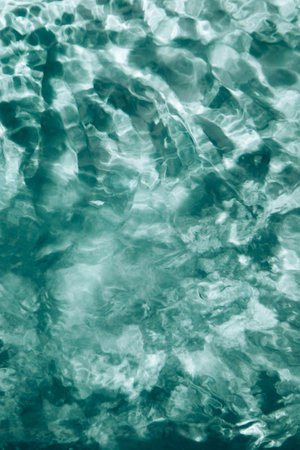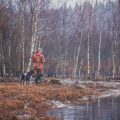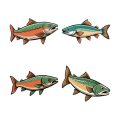1. Understanding Water Dynamics
Why Water Dynamics Matter for Anglers
If you want to fish like a pro guide, understanding water dynamics is key. Fish aren’t just randomly scattered; they follow patterns set by the movement and structure of water. Reading how current, flow speed, and water levels shift will help you predict where fish hang out—saving you time and putting more catches on your line.
Current, Flow Speed, and Fish Behavior
Fish use water current to their advantage. A strong current brings food downstream, while slower water gives them a place to rest. Knowing where these different speeds meet can help you find prime fishing spots.
| Water Feature | What Happens | Fishing Tip |
|---|---|---|
| Fast Current | Carries food & oxygen; fish may hold behind rocks or in eddies | Target seams where fast meets slow water; use heavier lures/weights |
| Slow Pools | Resting areas for fish; less food but safer from predators | Try natural presentations; lighter tackle works best here |
| Drops & Ledges | Create sudden depth changes; attract ambush predators | Work your lure along the edge or drop-off for strikes |
| Eddies & Backwaters | Calm spots behind obstacles; collect debris and insects | Perfect for drifting bait or flies gently into the area |
Reading Local River Patterns
When you show up at a river, look for signs of structure and current breaks. Fallen trees, boulders, and bends in the river all change how water flows. If you see ripples followed by smooth water, that’s often a seam—prime territory for hungry trout or bass waiting for an easy meal.
Quick Guide: Spotting Productive Areas in Rivers
- Bends: Deeper on the outside curve, slower on the inside—fish both sides!
- Riffles: Oxygen-rich, shallow—good for active feeders.
- Pools: Hold bigger fish resting or waiting for food to drift by.
- Obstacles: Any log or rock is likely shelter for a lurking fish.
Lakes: Reading Stillwater Like a Guide
Lakes don’t have visible currents like rivers, but wind and underwater structure matter just as much. Pay attention to points (where land sticks out), drop-offs, weed beds, and submerged timber. Wind-blown shores push food toward one side—smart anglers start there.
Lake Hotspots at a Glance:
| Laketype Structure | Why Fish Are Here |
|---|---|
| Main Lake Points | Bait gathers here—so do predators. |
| Shelves/Drop-Offs | Provide quick access to deep and shallow water. |
| Coves & Inlets | Sheltered from wind, warmer—good in early morning or evening. |
| Weed Edges & Timber | Shelter plus ambush zone—target with soft plastics or topwater lures. |
Learning how to read these features puts you one step ahead every time you hit the water. Up next: we’ll dig deeper into identifying key underwater structures guides rely on to locate big fish!
2. Identifying Productive Structure
Spotting Key Underwater Features Like a Pro
If you want to fish like a seasoned guide anywhere in the U.S., learning to spot underwater structure is a must. Guides don’t just cast blindly—they use their knowledge of how water shapes the land beneath to find where fish hide. Here’s how you can do the same.
Common Productive Structures in American Waters
| Structure Type | What It Looks Like | Why Fish Love It | Where to Find It |
|---|---|---|---|
| Drop-offs | A sudden change from shallow to deep water | Provides quick access to deep and shallow zones for feeding and safety | Lakes, reservoirs, river bends |
| Ledges | Underwater shelves or steps on the bottom | Act as ambush points and resting spots for fish | Bass lakes, rocky rivers, coastal areas |
| Submerged Cover (logs, brush, rocks) | Trees, branches, boulders hidden underwater | Offers shade, shelter, and attracts baitfish | Near shorelines, creek mouths, flooded timber zones |
| Weed Beds & Grass Lines | Patches or edges of aquatic plants | Baitfish hide here; predator fish hunt along the edges | Ponds, backwaters, shallow bays in lakes |
| Eddies & Current Breaks | Slow-moving pockets behind rocks or turns in rivers/streams | Fish rest here out of current while food drifts by | Streams, tailwaters below dams, riffle pools |
How Guides Identify Structure On The Water
1. Look for Changes in Water Color or Surface Texture
Darker water often means deeper water or submerged cover. Ripples or slicks can reveal rocks or weed beds just below the surface.
2. Use Electronics When Available
If you’re fishing from a boat with a fish finder or side imaging sonar, use it! These tools make it easy to spot drop-offs and ledges that aren’t obvious from above.
3. Read Shoreline Clues Like a Local Guide
The shoreline often mirrors what’s happening under the water. Steep banks usually mean quick drop-offs; points jutting into the lake often continue underwater as productive ledges.
4. Watch for Visible Cover Above Water
If you see trees fallen into the water or large boulders on shore, chances are there’s more hidden underwater nearby—prime spots for bass, crappie, and even catfish.
The Takeaway: Match Your Approach to Structure Type
Experienced guides pick their spots based on these structures because that’s where fish feed and hang out. Next time you’re on the water—whether it’s a southern reservoir, Midwest river, or New England pond—use these tips to identify productive structure and increase your odds of hooking up!
![]()
3. Reading Surface Clues
If you want to fish like a pro guide, you need to know how to read the water’s surface. Guides pay close attention to what’s happening on top of the water because it reveals where fish are likely holding and feeding. Let’s break down some essential surface clues—bubbles, seams, eddies, foam lines, and ripples—and how you can use them to find the perfect casting spots.
Bubbles and Foam Lines: Nature’s Drift Markers
Bubbles and foam lines act like arrows pointing out the main current and where food is drifting. Fish often hang out just below or alongside these lines because that’s where insects collect. When you see a distinct foam line, it’s a smart move to drift your fly or bait right along it.
Quick Reference: What Surface Clues Tell You
| Surface Clue | What It Indicates | Guide Strategy |
|---|---|---|
| Bubbles/Foam Lines | Main current, food conveyor belt | Cast along or just beside the line for active feeders |
| Seams | Where fast and slow water meet | Fish stack up here waiting for food to pass by |
| Eddies | Circular currents behind rocks/obstacles | Look for fish resting or picking off food in swirling water |
| Ripples | Slight surface disturbance over shallow structure or drop-offs | Target the edges for cruising or ambushing fish |
Seams: The Fish Freeway
A seam is where two currents meet—usually fast water next to slower water. Fish love seams because they can conserve energy in slower water while having easy access to food drifting by in the faster lane. Guides scan for visible lines on the surface where there’s a color or texture change in the flow. Casting parallel to these seams often pays off big time.
Eddies: Rest Stops and Feeding Zones
Eddies form behind rocks, fallen trees, or bends in the river, creating circular currents. These “rest stops” give fish a break from the current and concentrate food as it swirls around. Look for smooth patches of water next to choppy areas or behind obstacles—these are classic eddy spots that guides never ignore.
Ripples: Subtle Signs of Structure
Ripples on the surface often mean there’s something interesting underneath—like a submerged log, boulder, or sudden depth change. Fish use these areas for cover and ambush points. If you spot irregular rippling (not just from wind), try casting near those zones; chances are good there’s a fish lurking nearby.
Pro Tip: Watch Before You Cast
Guides don’t rush in—they watch the water first. Take a minute to observe bubble paths, seam lines, and eddies before casting. This simple step can help you spot subtle movements and pick the best target area for your presentation.
4. Adapting to Seasonal and Weather Influences
Any experienced fishing guide in the US will tell you that reading water isn’t just about knowing the river’s structure or watching for riffles and pools—it’s also about understanding how changing seasons, temperature swings, and weather fronts affect fish behavior and water flow. Here’s how guides adjust their approach as conditions shift throughout the year.
How Seasons Impact Water Structure and Fish Location
Fish move and feed differently depending on the time of year. Guides pay close attention to these patterns because where you found fish in spring might be totally empty by late summer. Check out this seasonal breakdown:
| Season | Water Conditions | Fish Behavior | Guide Strategies |
|---|---|---|---|
| Spring | Higher flows from snowmelt, cooler temps | Fish move into slower pockets to conserve energy | Focus on inside bends, eddies, and slower runs |
| Summer | Lower, warmer water; clearer visibility | Fish seek deeper holes & shaded areas to stay cool | Target undercut banks, deep pools, early morning or evening hours |
| Fall | Stable flows, cooling temps; increased insect activity | Fish are aggressive, preparing for winter or spawn | Look for fast runs near spawning gravel; use bigger flies or lures |
| Winter | Colder temps, slowest flows of the year | Fish become lethargic; hold deep and barely move | Nymph deep pools slowly; focus on midday warmth when fish are most active |
The Role of Weather Fronts and Temperature Swings
Guides watch weather patterns closely. Quick changes—like a cold front or sudden rainstorm—can shuffle the deck completely:
- Cold fronts: Fish often hunker down and become less active after a cold front passes. Guides slow presentations and hit deeper water.
- Warm fronts: Rising temps can spark feeding frenzies, especially in spring and fall. Guides take advantage by focusing on shallower water where fish might be cruising for food.
- Rain events: Light rain can get fish moving and feeding in shallow riffles. Heavy rain or muddy water usually pushes fish toward calmer backwaters or sheltered structure.
- Wind: A steady wind can push insects onto the surface, creating prime dry fly opportunities on lakes and rivers alike.
Telltale Signs Guides Look For in Changing Conditions
- Muddy vs. clear seams: After a rain, guides look for the “seam” where clear tributary water mixes with muddy main flow—these are prime ambush spots for predators.
- Bubbles & foam lines: These mark where food collects during high flows—guides target these spots year-round but especially after storms.
- Slicks on calm mornings: In the summer heat, guides hunt for shaded slicks early before sun drives fish deep.
Tuning In Like a Guide: Quick Tips for Every Angler
- If the weather changes overnight, be ready to change your tactics at the water’s edge.
- Pace yourself—if it’s cold or the river is up, work slow and deep. If it’s warming up or bugs are hatching, go shallow and fast.
- The best guides always have a backup plan—don’t be afraid to move until you find active fish!
5. Applying Guide Tactics on the Water
Approaching New Waters Like a Pro
When you hit the water, thinking like a seasoned American fishing guide can make all the difference. The best guides don’t just guess where the fish are—they read every clue, from the tiniest ripple to the biggest log jam. Here’s how you can use their tactics to break down any new river, lake, or stream with confidence.
Step-by-Step: How Guides Dissect New Water
| Guide Tactic | What It Looks Like in Action | Pro Tip from US Guides |
|---|---|---|
| Scout Before You Cast | Walk the bank or float slowly, looking for structure, seams, and holding water before even rigging up. | “I always spend 10 minutes just watching before I make my first cast.” – Montana guide |
| Read Structure First | Identify rocks, logs, drop-offs, and weed lines. Fish relate to these features for food and shelter. | “Fish are lazy—they love ambush points. Start there!” – Wisconsin musky guide |
| Analyze Current and Flow | Look for seams (where fast meets slow water), eddies behind boulders, and inside bends—prime fish spots. | “Watch for foam lines and bubbles—they’re fish highways.” – Colorado trout guide |
| Observe Insect Activity and Wildlife | Check what bugs are hatching or what birds are eating; it tells you what’s on the menu for fish. | “If swallows are swooping low over the water, there’s a hatch happening.” – Idaho fly fishing guide |
| Start Stealthy and Work Outward | Begin close to shore or near your boat—fish right at your feet before casting further out. | “The first cast should be your best shot; don’t spook the pool!” – Pennsylvania smallmouth guide |
Real-World Example: Breaking Down a Classic American River Bend
You pull up to a bend on a Midwest river. Here’s how a local guide might approach it:
- First, scan for visible cover: Look for submerged timber along the outside bend—likely bass or pike hangouts.
- Next, check flow patterns: Notice where fast current meets slow water. Trout often hold just at this seam waiting for food.
- Test different depths: Start shallow near shore, then work deeper as you move downstream with each cast.
- Mimic natural prey: Match your lure or fly to what’s hatching or swimming around. If grasshoppers are hopping bankside, try a hopper pattern.
- Keep moving: Guides rarely stay in one spot too long if they’re not getting bites—cover water methodically until you find active fish.
Troubleshooting Common Mistakes—What Guides Wish You Knew
- Avoid “blind bombing” casts: Always have a reason for where you throw your lure or fly.
- Don’t ignore subtle signs: A swirl or flash could mean feeding fish—pay attention!
- Stay flexible: If one approach isn’t working, switch tactics quickly like guides do.
- Pace yourself: Slow down and let the water tell its story; guides succeed by being observant more than aggressive.
Your Next Step: Practice Makes Perfect
The more you practice these guide-inspired approaches on your local waters, the sharper your instincts become. Whether you’re chasing largemouth in Texas lakes or wild trout in Appalachian streams, these tactics help you fish smarter—not harder—just like an American pro guide would.


